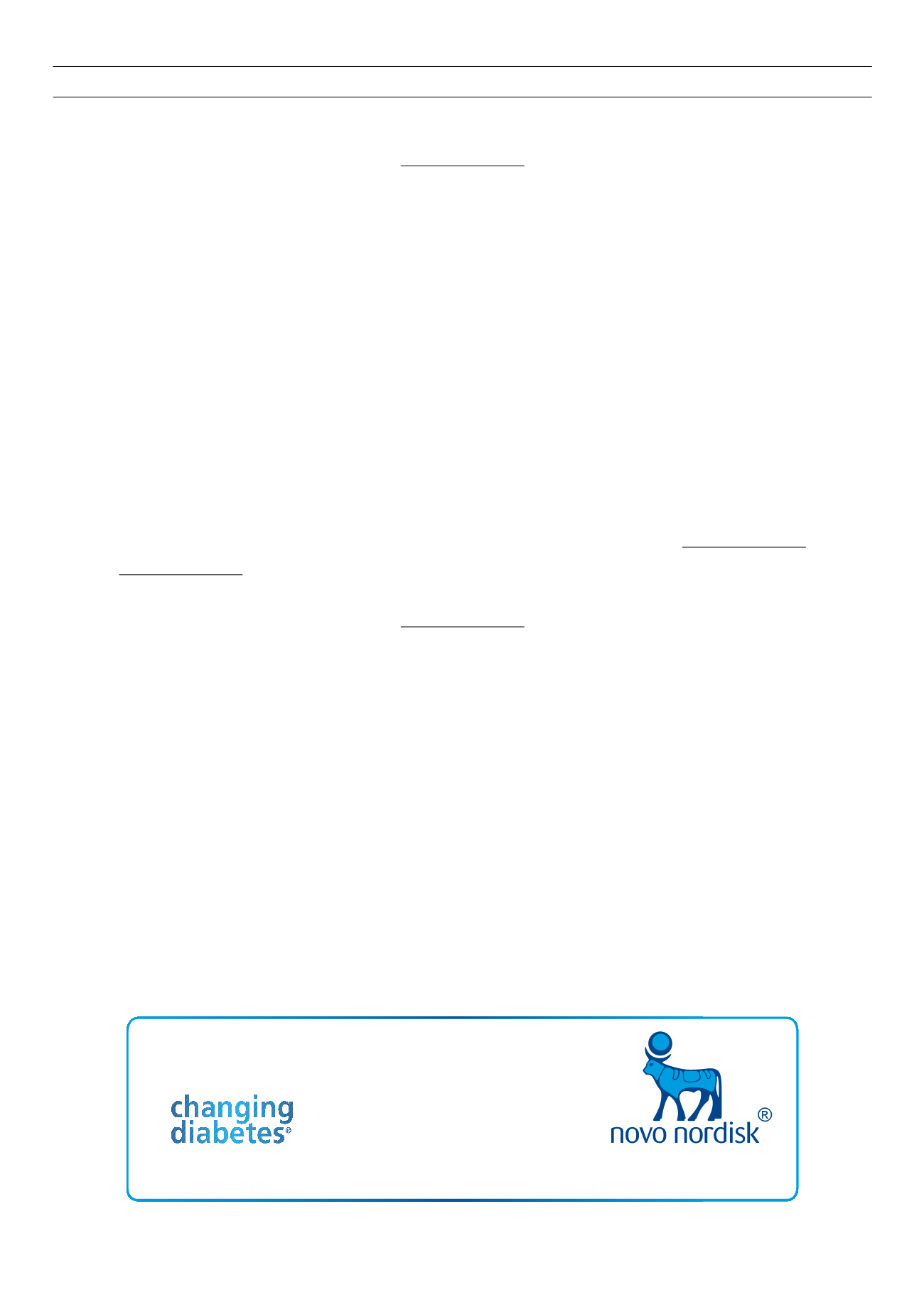
126
VOLUME 7 NUMBER 3 • SEPTEMBER 2010
ADA WATCH
SA JOURNAL OF DIABETES & VASCULAR DISEASE
Reducing complications of
diabetes
Infliximab treatment improves
visual acuity in diabetic macular
oedema that does not respond to
laser photocoagulation
This small phase III study suggested that
larger and long-term trials should be under-
taken to assess the efficacy of the systemic
or intravitreal anti-TNF monoclonal anti-
body, infliximab, to improve the vision of
patients with diabetic macular oedema
refractory to laser therapy.
This single-centre, double-blind, ran-
domised, placebo-controlled, crossover
study in 11 patients showed that intrave-
nous infliximab (5 mg/kg) at weeks zero,
two, six and 14, followed by placebo to
32 weeks, improved visual acuity by 24%
compared to placebo-treated eyes.
Source: Presidents Poster 0416-PP. Tentolouris IV,
Grigcropoulos V, Emfietzoglou I,
et al
. Infliximab for
diabetic macular edema refractory to laser photo-
coagulation.
Point-of-care testing of diabetic
keto-acidosis avoids unnecessary
DKA work-ups in hyperglycaemic
patients presenting at emergency
departments
The poor specificity of urine dipstick tests
for diabetic ketones resulted in a high false-
positive rate with increased hospital costs.
This study used the point-of-care (POC)
capillary beta-hydroxybutyrate test (the
Precision Xtra meter, Abbott Laboratories)
to obviate these additional costs.
Five hundred hyperglycaemic patients
admitted to the emergency department
were enrolled in the study and 53 met all
ADA criteria for DKA. The urine dipstick
had a sensitivity of 98%, but a specificity
of 40%, whereas use of the Precision Xtra
meter had an equal sensitivity but a specifi-
city of 80%, thereby significantly reducing
unnecessary DKA work-ups in hyperglycae-
mic patients.
Source: Presidents Poster 0386-PP. Arora S, Peters AL,
Long T,
et al
. Utilising point-of-care testing to identifiy
diabetic ketoacidosis at emergency department triage:
beta hydroxybutyrate vs urine dip.
Rotating glucometer usage after
achieving glucose control in the
first patient improves HBA
1c
levels
in resource-constrained settings in
Kenya
A home glucose-monitoring programme
for Kenyan patients with an HbA
1c
above
10% and a cell phone has shown a mean
drop in HbA
1c
of 3% in a remotely managed
cost-effective process of diabetes care.
Patients are given a glucometer and pro-
vided with glucose testing strips. They are
called weekly by community workers, who
record their results and relay the informa-
tion to clinicians, who then adjust the insu-
lin dose based on a standardised protocol.
Once a patient achieves good control,
he/she returns the glucometer, which
is then given to another patient. The
researchers plan to extend this model to
rural areas of Kenya.
Source: Presidents Poster, Abstract No 0432-PP. Ouma
MN and Pastakia SK. A comprehensive collaborative
enhanced diabetes care program in the rural resource
constrained setting of Eldoret (western) Kenya.
Poor glycaemic control slows
wound healing
This evaluation of raw data from several
multi-centre, randomised, FDA-approved
clinical trials among similar populations
incorporated 411 diabetic patients with
neuropathic foot ulcerations and evaluated
the clinical and laboratory data during a
12-week period of wound healing.
The relationship between HbA
1c
and
successful wound healing over 12 weeks
of standardised treatment was then evalu-
ated. After adjusting for covariates (dura-
tion of diabetes, age, gender, race, etc), the
evaluation showed that the odds of healing
decreased by 15% for every 1% increase
in HbA
1c
during the preceding 12 weeks of
wound care.
Source: Abstract 0189-OR. Cook EA, Cook JJ, Henao
M,
et al
. The importance of sustained glycaemic control
during wound healing.
Encouraging and educating physi-
cians can result in earlier insulin
prescription with enhanced HBA
1c
control
Using the updated ADA/EASD consen-
sus statement, which includes earlier use
of insulin in patients not achieving HbA
1c
goals on metformin and lifestyle, this cer-
tified diabetes educator (CDE) programme
increased insulin use rates from 25 to 39%.
Patient HbA
1c
values improved with the
proportion of diabetics with HbA
1c
>
8.5%
dropping from 36 to 24%.
The intervention was not too labour
intensive, and was conducted over six
months and included three main compo-
nents: office-based education, print and
monthly e-mail reminders.
Source: Abstract 0108-OR. Endsley S, Leal S, Choi J,
Martinez AN. An office-based physician education
program to enhance the earlier initiation of insulin: An
evaluation of an academic detailing intervention in the
US.
Cardiovascular outcomes trial initi-
ated for liraglutide
Novo Nordisk announced at the ADA meet-
ing details of the company’s cardiovascular
outcomes trial for liraglutide, which is set
to start in the autumn of 2010.
The LEADER
™
trial (Liraglutide Effect and
Action in Diabetes: Evaluation of cardiovas-
cular outcome Results) aims to assess and
confirm the cardiovascular safety of the
company’s new once-daily human GLP-1
analogue and potentially show its ability to
improve cardiovascular outcomes. The trial
also satisfies the new FDA guideline for
type 2 diabetes treatments.
The protocol has been designed in close
collaboration with an international expert
steering committee as well as US and EU
regulatory authorities, and with assistance
from the Population Health Research Insti-
tute (PHRI) at McMaster University, Canada.
Furthermore, an independent data-moni-
toring committee will monitor progress of
the trial and ensure that it meets the high-
est standards of ethics and patient safety.
Novo Nordisk (Pty) Ltd. Reg. No.: 1959/000833/07. PO Box 783155, Sandton, 2146. Tel: (011) 202 0500 Fax: (011) 807 7989 NN/DUO/4145/07/10/VER1


